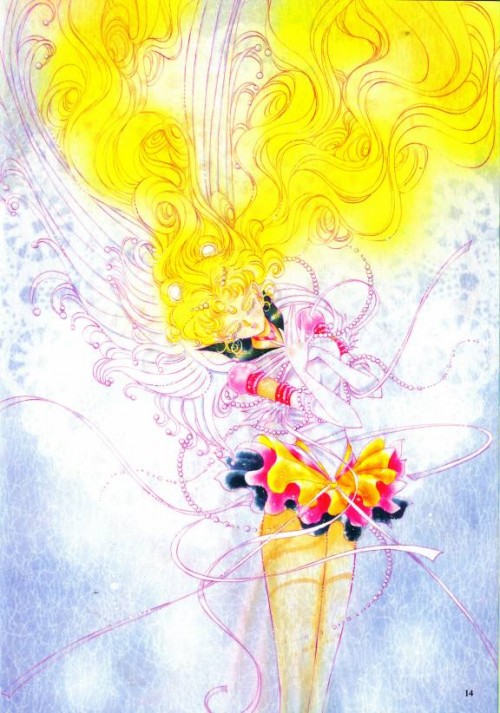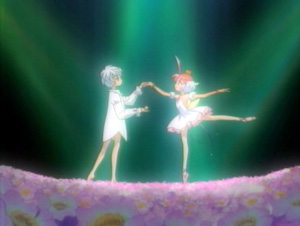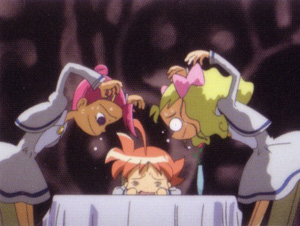In 12 episodes, Puella Magi Madoka Magica convinced me that there’s more to Akiyuki Shinbo than otaku-pandering. The director has increasingly been held in high regard, but until Madoka, I’d not taken any substantial steps into his oeuvre. Not even Bakemonogatari coaxed me in, but post-Madoka, I’ve found a lot of new respect for the man.
Experimental and fearless is how I’d describe the series, as not only does it impose a very specific, artsy aesthetic on a subject matter reserved for the hardcore, it also takes a hard-line with its young characters. Much like Bokurano, it never backs down, or allows for an easy way out.
Tag: magical girl

If you haven’t done yourself the favour of reading the original Sailor Moon manga, I suggest you drop whatever stigmas or preconceptions you have of the series and find yourself a copy. Naturally, it suffers from the cliches it helped to establish: baddies-of-the-moment, elaborately named attacks, and a penchant for all the bad parts of 80s women’s fashion. Coupled with the toxic sweetness of Mamoru and Usagi’s relationship, if you go in expecting anything less than the crown jewel of the magical girl genre, you’ll be going in horrendously underprepared. That said, the manga has its merits, and Sailor Moon is definitely one of those “read the manga, skip the anime” type affairs. Any fan of really, really well-drawn and well-paced manga should read Sailor Moon.
 This week I’m off work, my first real break since August; no early mornings, no tired evenings, just hours and hours of free time. When I realized I had the opportunity to spend this most precious of weeks working my way through a long-ignored anime series, I could have wasted ages agonizing over the decision, weighing up the relative pros and cons as a scientist may treat his next great project, yet it was quite the opposite – two elegant words immediately jumped (or should I say, danced?) to mind: Princess Tutu. And that was that; seven episodes later, these are my first impressions.
This week I’m off work, my first real break since August; no early mornings, no tired evenings, just hours and hours of free time. When I realized I had the opportunity to spend this most precious of weeks working my way through a long-ignored anime series, I could have wasted ages agonizing over the decision, weighing up the relative pros and cons as a scientist may treat his next great project, yet it was quite the opposite – two elegant words immediately jumped (or should I say, danced?) to mind: Princess Tutu. And that was that; seven episodes later, these are my first impressions.
Now, I know a lot of you must be thinking, “Princess Tutu?! Bateszi’s gone soft…” But you know what, underneath it all, I’m not into anime for any macho bullshit reasons. I enjoy heartfelt characterisation and relationships, fantastic stories and symbolic drama. It doesn’t matter whether I’m watching never-ending shonen fare like Naruto or magical girl anime like Pretear, what counts most is empathy, and I’ve always heard interesting things about Princess Tutu, about how it’s more than just cliche shojo.
 Wikipedia describes the series as a “meta-fairytale”. Essentially, Princess Tutu is a story within a story, an elegant and magical fusion of fairytale tropes that conforms to the conventional structure of “magical girl” anime (including the per-episode transformation into titular magical girl) yet constantly plays with its fantastic reality; like, amidst the more typical anime characters, we have the odd talking animals walking around and dressed as humans – a school-aged female anteater being one of the most bizarre examples. No one is surprised by this; the kids just carry on as normal.
Wikipedia describes the series as a “meta-fairytale”. Essentially, Princess Tutu is a story within a story, an elegant and magical fusion of fairytale tropes that conforms to the conventional structure of “magical girl” anime (including the per-episode transformation into titular magical girl) yet constantly plays with its fantastic reality; like, amidst the more typical anime characters, we have the odd talking animals walking around and dressed as humans – a school-aged female anteater being one of the most bizarre examples. No one is surprised by this; the kids just carry on as normal.
It’s somewhat unsurprising then that clumsy main character Ahiru happens to be a duck, albeit a duck that can transform into a squeaky-voiced, ballet-dancing Japanese school girl. She loves the Prince but the rules of her magic dictate that she can never confess her feelings, lest she will vanish into thin air, and yet still, she will stop at nothing to see her Prince smile. Ahiru’s an adorable character; eccentric, selfless and full of fluttering butterflies, she so obviously deserves a happy ending.
 Her quest for an unlikely romance is the core of the story, but I feel like I’ve barely scratched the surface. Simply describing the narrative is one thing, yet there is so much to say about the unique use of ballet, opera and theatrical music; you see, Princess Tutu doesn’t defeat her enemies; she dances into their frozen hearts. The misty landscapes, vintage architecture and moody lighting conjure an atmosphere of magic and whimsy as the characters laugh and cry with a melodramatic innocence and honesty. In many ways, it’s like watching a beautiful theatrical performance or reading a classic fairytale, each character destined to fulfil their fated roles as heroes or villains, but an interesting twist is their rebellion against fate; they are confused and conflicted by their subtle emotions, lost in an unfinished fable where good and evil aren’t supposed to be complicated.
Her quest for an unlikely romance is the core of the story, but I feel like I’ve barely scratched the surface. Simply describing the narrative is one thing, yet there is so much to say about the unique use of ballet, opera and theatrical music; you see, Princess Tutu doesn’t defeat her enemies; she dances into their frozen hearts. The misty landscapes, vintage architecture and moody lighting conjure an atmosphere of magic and whimsy as the characters laugh and cry with a melodramatic innocence and honesty. In many ways, it’s like watching a beautiful theatrical performance or reading a classic fairytale, each character destined to fulfil their fated roles as heroes or villains, but an interesting twist is their rebellion against fate; they are confused and conflicted by their subtle emotions, lost in an unfinished fable where good and evil aren’t supposed to be complicated.
I’ve been an advocate of Red Garden since the first episode, but until this past weekend I hadn’t seen beyond episode three. Red Garden isn’t easy to watch – if the characters aren’t paralysing my brain with screaming, tearful grief, they start singing instead. I like that the show is trying something different with the insert songs, but put simply, it doesn’t sound good, it feels awkward and out of place.
Regrettably the horror element is fairly dull too – the episodic monsters are just bland zombies, minus the gore. The girls fight them off with wooden sticks and baseball bats; what happened to the samurai swords? This is Japan after all. We want severed limbs, decapitations, blood squirting from major veins, all that good stuff. If GANTZ has three good things going for it, it is imaginative monsters, big guns and exploding heads. Red Garden could be cooler with a little bit more of the old ultra-violence.
That said I’ve now caught all the way up to episode 12. I’m watching for bald sensation Dr. Bender (nice name), only kidding – but the characters, and especially the four central girls, are interesting personalities showing some important social development. Kate was hopelessly isolated by her own perfection, Rachel consumed by a superficial life of fashion and parties, Claire needlessly pushing others away to prove she can live on her own terms and Rose was locked down by a broken home. In each of their own ways they were lonely and ironically, only in death have they found the true friendship they so desperately needed. Their apparent misfortune has become an escape from the prison of their regular lives. To see them change over the first half of the series has been a worthwhile journey, sometimes hard-going and slow, but none the less heart warming. The real test will be when they have to choose whether or not to return to their old bodies. Red Garden excels outside of the horror angle, and is just much more riveting as character drama. The character designs are still as beautiful as ever (I love how they change costume from episode to episode too, every episode is refreshingly different; this is a rare thing for a viewer as entrenched in Naruto style same-clothes-every-day-every-year as myself).
So despite the singing sucking, the horror being dull, Red Garden is proving itself a brazen, involving character drama. And the yuri fans have GRACE.
Red Garden – 3 – Theatrical heart break
Episode 3 of Red Garden is the best yet; the viewer leaves this instalment drenched in suspense, mystery and blood, and all the while we’re slowly beginning to understand what’s happened to the girls – or rather, how they died! There are still big question marks hanging over why they were all together on *that* night (since they were never friends before all this), and why must they fight the “dog men”? I’m desperate to know the answers.
This is a show that looks absolutely ravishing, but it can be absolutely brutal too. The death scenes in this episode are especially harrowing because of the voice acting – the way the victims scream; they sound genuinely terrified and desperate. We glimpse at another group of girls who, just like the main characters, have to fight the monsters to live – but they have given up hope and die in the throws of painful physical violence; we hear strangled throats buckle and bones break. I’m getting frustrated with characters running scared now though – the girls need to bring weapons. Swords. Anything!
I’ve also realised that Red Garden has a brilliant soundtrack. Composed by Akira Senju, the music in this episode was particularly compelling; full of dread, sadness and realisation. The style suggests a very emotional and sweeping opera, a worthy match for such an elegant series.
Having now taken in three episodes, I don’t hesitate to say that Red Garden is my favourite show of the season. Death Note is suspenseful and thrilling, but Red Garden combines such a theatrical and stylish art direction with a heart breakingly mysterious story that just begs to be watched. I need more!
I do love mysterious horror stories, especially when the viewer is as much at a loss as to what is going on as the characters themselves. The supernatural Red Garden is growing with this creeping intrigue, it’s bizarre and confusing and a lot of my interest is now centred on eventually finding answers.
In some quarters it is being compared with Gantz, though beyond the familiar premise of confused teenagers fighting off an unknown enemy, it’s a misleading reference. Where Gantz was extremely cold, violent and absolutely cynical, Red Garden has fluffy hair cuts, scared girls breaking out into theatrical song and air-heads more worried about ripping their expensive shirts than being eaten by werewolves. It’s a completely feminine anime, where fashion sense collides with survival. Elegant and extremely self conscious.
The characterisation feels very American, drawing on stereotypical high school cliques to bring together four distinct personality types, but it works quite well in the heat of battle with the girls forced to put aside their superficial differences and fight to survive. The constant crying and self pity can be tiresome, but it makes a refreshing change to see people who are genuinely too scared to move when faced with a razor toothed terror.
Many people couldn’t be bothered with Vision of Escaflowne because the character designs sported big noses. The almost-ignored Fantastic Children suffered from this same shallow discrimination. I dare say both of these are modern classics, and now Red Garden will face the exact same battle against a community that largely considers the likes of Kanon the epitome of animated beauty. What went wrong?
For me this is hands down the best looking show of the fall season. Alongside the vastly different but none the less outstanding Kemonozume, Red Garden makes an immediate impression with its angular character design and eye catching colour scheme. It is like watching a feminine art book in full motion; bursting with attitude and elegance, bridging the gap between the colourful teenage exuberance of FLCL and grandiose beauty of Paradise Kiss. However keeping in mind Red Garden is being produced by GONZO, whether they can maintain these high standards remains to be seen.
Unfortunately there is something seriously wrong with this episode; the insert song. Taking its magical girl influence to scary new extremes, a particularly tearful girl breaks out into the kind of spectacularly cringe inducing, brain melting song fit to grace hell. I’m all for experimental anime, but this girl can’t sing. Fact.
I haven’t seen a good magical girl anime since Mahou Shoujotai, but on this evidence Red Garden’s wonderful style and enthusiastic charisma may well win over my heart.
Having stumbled across the passionate rants and pretty pictures over at the Star Crossed anime blog, I decided I’d take a chance on a magical girl anime called Mahou Shoujotai (also known as Tweeny Witches or Magic-Girl Squad – Alice).
Up until checking out Mahou Shoujotai, my only other experiences of the traditional magical girl anime had been Pretear (surprisingly watchable, if ever so gay) and Sailor Moon (something about a doom tree; I couldn’t get past two episodes without falling into the clutches of apathetic depression).
Despite my concerns that with this being a kid’s anime and all it would be laying on the morals a little thick, it turns out that Mahou Shoujotai is an enchanting fantasy adventure, conjuring up such an inventive, colourful feeling of excitement without ever pandering to the imposed squeaky clean innocence of Western children’s cartoons. Sometimes dark, but always fun and passionate, Mahou Shoujotai never loses its attractive sense of humour amidst a punky visual style and overwhelming fantastical adventure.
The story is- just like Alice in Wonderland- about a girl (called Alice, actually) who somehow falls into a world of magic where witches and warlocks are apparently at war. This is merely the beginning of the story (I’ve only seen up to episode 16 myself) but Alice’s journey, amidst much broom flying, odd creatures and magic spells- is an emotional rollercoaster of forming friendships and dealing with the reality of broken homes.
One of my favourite anime houses Studio 4°C is the primary driving force behind the look and feel of Mahou Shoujotai and their crazy, experimental style works perfectly within the boundless confines of Alice’s strange new world; truly everything looks weird and colourful and fun in ways rarely seen outside of anime produced by Studio Ghibli. It’s rare to find a children’s anime that evokes such a free wheeling, awe inspiring sense of adventure and fun. Mahou Shoujotai is magical in every way.